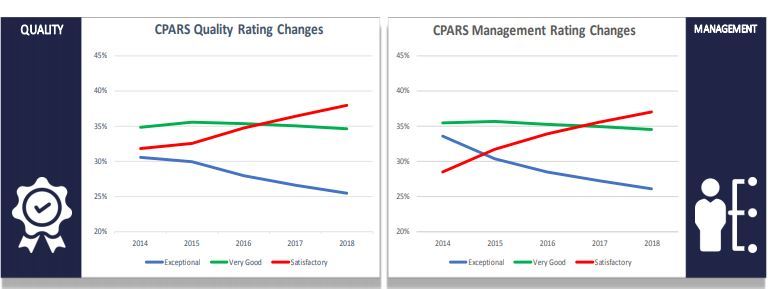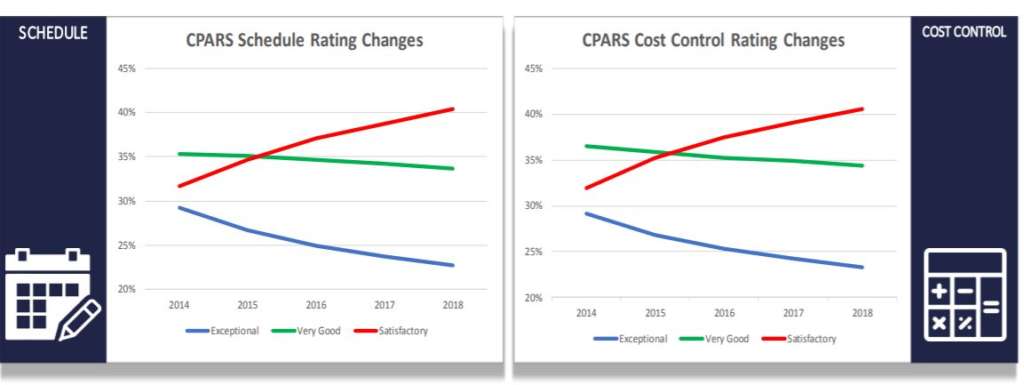
Why contractor past performance data is becoming both more, less valuable
New analysis from GovConRx found agencies are giving vendors “satisfactory” past performance ratings more often than any other rating because the system is too...
When the General Services Administration released the $65 billion Alliant 2 governmentwide acquisition contract for IT services back in June 2016, it was one of the first major procurement efforts to put a premium on past performance.
As part of the self-scoring approach to Alliant 2, GSA determined that 40 percent of the evaluation points would be on how vendors have performed on previous and similar work with the government.
At the time, industry analysts praised GSA for building on this self-scoring approach.
Now three years later, the self-scoring approach where past performance is a significant evaluation factor has grown in popularity.
At the same time, vendors and federal procurement officials alike heed a common call that the current approach to obtaining past performance is problematic and needs to be rethought.
“As the government moves to buying more services and solutions, things are getting more subjective and you want to be able to do a better job of motivating contractors to do more,” said Jim Williams, a former federal executive with GSA, the IRS and the Homeland Security Department, and now a principal with Williams Consulting, LLC and an advisor for GovConRx. “The forces are coming together to say vendor past performance is a valuable tool. But it’s not working as it should because it’s too burdensome and not as accurate as it should be. No one wants to throw it out. We just want to fix it.”
Experts say the current system, the Contractor Performance Assessment Reporting System (CPARS), takes too much time to fill out, lacks important details and isn’t as accurate as it needs to be.
“The time and effort to draft CPARS evaluations is too much, and with most agency contracting staffs pressed to do more with less, that gets pushed out further, especially if there is a need to justify ratings over satisfactory,” said Mike Smith, a former DHS director of strategic sourcing and now executive vice president at GovConRx. “There needs to be some way to justify anything over satisfactory that is not so hard to track down all the information so it becomes less cumbersome. Contractors also are not actively engaged in the documentation and support of the ratings. That has to change too, especially as agencies are paying a lot more attention to ratings. We have to figure out how to make sure past performance ratings are not done in haste.”
Smith said on average, depending on the type of procurement, it could take a contracting officer a few minutes to a few hours to write an in-depth CPARS review.
New data compiled by GovConRx shows the value of CPARS is dropping dramatically.
Between 2014 and 2018 across the four areas of CPARS—quality, management, schedule and cost control—the number of satisfactory ratings have consistently increased while the number of exceptional ratings bottomed out and the number of very good ratings also are a downward trajectory.


“We’ve seen some changes and a bigger emphasis in using CPARs for source selection decisions, but we don’t think the government is getting the same value for what the evaluations were designed for in the first place,” said Ken Susskind, founder and CEO of GovConRx. “We talked to quite a few agencies and chief procurement officers and we are hearing there is not enough detail or accuracy in CPARS for them to rely on to make educated and informed decisions during the source selection process. And then we hear from a lot of contractors that they believe they are performing at an exceptional and very good level, but they are getting satisfactory ratings in CPARS.”
And getting satisfactory ratings in CPARS combined with the increased importance of past performance makes a bad recipe for both agencies and vendors. especially because the real value of the data is in the comments written by contracting officers. Experts say contracting officers don’t believe they have the time to justify ratings above or below satisfactory so it’s easier just to give everyone an average rating.
Lesley Field, the deputy administrator in the Office of Federal Procurement Policy, said the chief acquisition officer’s community is recognizing the value of CPARS is diminishing.
“I do think it’s time to reimagine what that systems could do and how it could support our acquisition workforce,” Field said in an interview with Federal News Network. “There is a lot of data in the system, but it may be a little difficult for folks to pull out what they need. We want to make sure the data is accessible and relevant. So we are thinking about ways to start a modernization effort for CPARS so the system can produce information that is more actionable and usable for our contracting officers.”
Field said the data needs to be more specific and better reflect how vendors are performing.
OFPP is beginning a new “in-reach” effort to talk to the frontline workers to ensure they have the tools and training to do their jobs better.
Soraya Correa, the chief procurement officer at DHS, said her office is part of a group of agencies starting to work with OFPP on reinventing CPARS.

She said it’s clear CPARS has become tedious and there can be too much back and forth with vendors over the ratings and comments. Correa added past performance needs to be simplified and automated to some extent.
“If we use something like artificial intelligence or automation tools to simplify data and sort the data so we can present it in a more streamlined fashion, CPARS would be more valuable for contracting officers,” Correa said in an interview. “I would love to see a more commercial past performance approach, almost like a Yelp approach. Vendors can add comments to the government’s ratings, but there wouldn’t be a back and forth. The contracting officers could have a tool so they can search for projects similar in size, scope and complexity. That is one of the things we look for. They can run a report and it tells them what ratings came back at and key comments from vendors and the government.”
Field said agencies need to keep up with the times so a “Yelp for government” isn’t necessarily a bad idea and is a model to explore and possibly pilot changes to CPARS to make it more in-line with commercial practices.
“What we would like to play with is if there are AI tools out there or emerging technologies that could look across the evaluations, maybe help us come up with more insight,” she said. “Would it be possible to look at the Federal Data Procurement System data and figure out what other awards are out there and if anything interesting pops up? It’s really a holistic reimagining of what that past performance system could do. Obviously, the contracting officers are the ones who will have to make that assessment, take all that information and evaluate it and use their judgement.”
Field said it’s still early in the process to reimagine CPARS, especially as GSA transitions it to a new platform, beta.sam.gov, in the coming months. Field said OFPP is working with a few agencies to figure out what the future of vendor past performance could look like.
Correa said DHS is one of those agencies working with OFPP on modernizing CPARS. She said emerging technologies, like AI, will promote both the use of past performance data and the need to make sure CPARS information is a higher quality.
One common complaint is CPARS doesn’t necessarily include or have room for private sector past performance data.
Both Correa and Field agreed that obtaining that information would be helpful, especially as agencies strive to find non-traditional contractors.
“I do think CPARS is a good tool. We’ve come a long way with that tool. I remember when we first implemented it and it was much more difficult to use. They continue to make improvements on CPARS, the system itself,” Correa said. “I just want to take advantage of automation and the technologies that are available to help us cull the data, simplify it and bring it back in a fashion to the contracting officers that is simple, straightforward and easy to use. If along the way, we can tailor the data requirements, how we get data into the system, how the CORs, program managers and contracting officers interact with the system to get their data in the system and pull it back, then we will have an ideal tool.”
Copyright © 2025 Federal News Network. All rights reserved. This website is not intended for users located within the European Economic Area.
Jason Miller is executive editor of Federal News Network and directs news coverage on the people, policy and programs of the federal government.
Follow @jmillerWFED
Related Stories

OFPP tells agencies to get serious about tracking contractor performance




